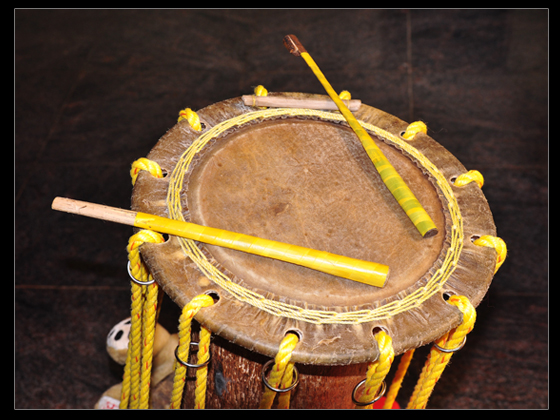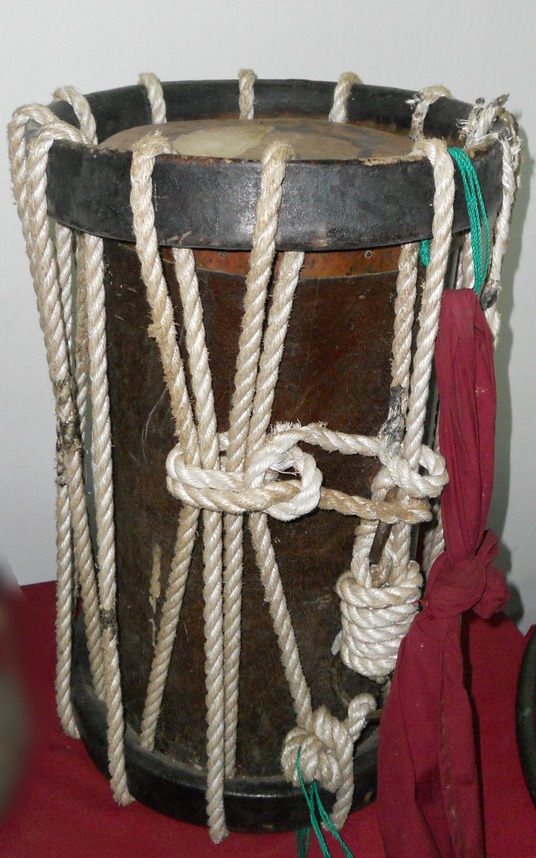|
Chenda
The Chenda ( ml, ചെണ്ട, ) is a cylindrical percussion instrument originating in the state of Kerala and widely used in Tulu Nadu of Karnataka and Tamil Nadu in India. In Tulu Nadu (Coastal Karnataka), it is known as ''chende''. It is greatly identified as a cultural element in Kerala and Tulu Nadu. This instrument is famous for its loud and rigid sound. A Chenda has two sides, the left side called " Edamthala" (ഇടം തല)(Left Head) and the right side " Valamthala" (വലം തല)(Right Head). The "Edamthala" is made of only one/two layer of cow skin and the "Valamthala" will have a five/seven layer skin, so as to have a bass sound. The skin are dried in the shade and fastened on wooden rings (Chenda Vattam, ചെണ്ട വട്ടം) made of the trunk of a locally available palm tree (Eeranpana) or bamboo, using a gum prepared from the seed of a tree called "pananchi maram". The circular frame is kept in a vessel, boiled for an entire day and th ... [...More Info...] [...Related Items...] OR: [Wikipedia] [Google] [Baidu] |
Chenda Melam
The Chenda ( ml, ചെണ്ട, ) is a cylindrical percussion instrument originating in the state of Kerala and widely used in Tulu Nadu of Karnataka and Tamil Nadu in India. In Tulu Nadu (Coastal Karnataka), it is known as ''chende''. It is greatly identified as a cultural element in Kerala and Tulu Nadu. This instrument is famous for its loud and rigid sound. A Chenda has two sides, the left side called "Edamthala" (ഇടം തല)(Left Head) and the right side "Valamthala" (വലം തല)(Right Head). The "Edamthala" is made of only one/two layer of cow skin and the "Valamthala" will have a five/seven layer skin, so as to have a bass sound. The skin are dried in the shade and fastened on wooden rings (Chenda Vattam, ചെണ്ട വട്ടം) made of the trunk of a locally available palm tree (Eeranpana) or bamboo, using a gum prepared from the seed of a tree called "pananchi maram". The circular frame is kept in a vessel, boiled for an entire day and ... [...More Info...] [...Related Items...] OR: [Wikipedia] [Google] [Baidu] |
Chande
The ''chande'' is a drum used in the traditional and classical music of South India and particularly in Yakshagana theatre art of Karnataka. It follows the Yakshagana Tala system. The rhythms are based on pre-classical music forms that Karnataka Sangeta and Hindustani Sangeetha are based on.''Prof. Sridhara Uppura, Yakshagana and Nataka, Diganta Sahitya Publications, 1998, Managalore. There are different varieties of this instrument; two major varieties being the ''Badagu Thittu Chande'' (Northern School) and the ''Thenku Thittu Chande'' (Southern School). The latter can also be spelled ''chenda'' and is used exclusively in the art forms of southern coastal Karnataka and Kerala. This article deals with ''Badagu Thittu Chande'', used exclusively in Yakshagana of Karnataka. The chande used in ''Badagu Thittu'' is structurally and acoustically different from the ''chenda'' used in Kerala. History In ancient Hindu sculpture, painting, and mythology, the ''chande'' is often depi ... [...More Info...] [...Related Items...] OR: [Wikipedia] [Google] [Baidu] |
Edamthala
Uruttu Chenda (ഉരുട്ട് ചെണ്ട) is a type of "Chenda" or drum used to play variations in Chenda music. It is used to lead the orchestra. It is called the ""Pramanavadhya"" (Leading instrument). The "Chenda Vattam" of the "Uruttu Chenda" is always the "Edam Thala" or the "Left Head" which is made of soft, single cow skin. The meaning of "uruttu" in Malayalam language is "rolling". The artist produce sound on "Uruttu Chenda" by rolling his right hand wrist. During the first beat the palm holding the stick will face the artist (in), then during the second beat (using the same right hand) the palm would face the opposite side (out). This is done by rolling the wrist. The Chenda is a cylindrical percussion instrument used widely in the state of Kerala, and Tulu Nadu of Karnataka State in India. In Tulu Nadu it is known as ''chande''. It has a length of two feet and a diameter of one foot. Both ends are covered (usually with animal's skin) with the "Chenda Vatta ... [...More Info...] [...Related Items...] OR: [Wikipedia] [Google] [Baidu] |
Veekku Chenda
Veekku Chenda (വീക് ചെണ്ട) or "Acchan Chenda" (അച്ഛൻ ചെണ്ട) is a type of Chenda or drum used to keep the "thalam" or the basic rhythm while playing the Chenda. The "Chenda Vattam" of the "Veekku Chenda" is always the "Valam Thala" or the "Right Head" which is made of multiple layer of skin to produce a bass sound. The meaning of "Veekku" in Malayalam language is "beating hard". The artist produce sound on "Veekku Chenda" by hitting the drum using a stick without twisting or rolling his wrist. The Chenda is a cylindrical percussion instrument used widely in the state of Kerala, and Tulu Nadu of Karnataka State in India. In Tulu Nadu it is known as ''chande''. It has a length of two feet and a diameter of one foot. Both ends are covered (usually with animal's skin) with the "Chenda Vattam". The animal skin is usually of a cow (Heifer), in a traditional Chenda other skins are not used (skin of bull, ox etc. are not used), to have a quality ... [...More Info...] [...Related Items...] OR: [Wikipedia] [Google] [Baidu] |
Edam Thala
Uruttu Chenda (ഉരുട്ട് ചെണ്ട) is a type of "Chenda" or drum used to play variations in Chenda music. It is used to lead the orchestra. It is called the ""Pramanavadhya"" (Leading instrument). The "Chenda Vattam" of the "Uruttu Chenda" is always the "Edam Thala" or the "Left Head" which is made of soft, single cow skin. The meaning of "uruttu" in Malayalam language is "rolling". The artist produce sound on "Uruttu Chenda" by rolling his right hand wrist. During the first beat the palm holding the stick will face the artist (in), then during the second beat (using the same right hand) the palm would face the opposite side (out). This is done by rolling the wrist. The Chenda is a cylindrical percussion instrument used widely in the state of Kerala, and Tulu Nadu of Karnataka State in India. In Tulu Nadu it is known as ''chande''. It has a length of two feet and a diameter of one foot. Both ends are covered (usually with animal's skin) with the "Chenda Vatta ... [...More Info...] [...Related Items...] OR: [Wikipedia] [Google] [Baidu] |
Kerala
Kerala ( ; ) is a state on the Malabar Coast of India. It was formed on 1 November 1956, following the passage of the States Reorganisation Act, by combining Malayalam-speaking regions of the erstwhile regions of Cochin, Malabar, South Canara, and Thiruvithamkoor. Spread over , Kerala is the 21st largest Indian state by area. It is bordered by Karnataka to the north and northeast, Tamil Nadu to the east and south, and the Lakshadweep Sea to the west. With 33 million inhabitants as per the 2011 census, Kerala is the 13th-largest Indian state by population. It is divided into 14 districts with the capital being Thiruvananthapuram. Malayalam is the most widely spoken language and is also the official language of the state. The Chera dynasty was the first prominent kingdom based in Kerala. The Ay kingdom in the deep south and the Ezhimala kingdom in the north formed the other kingdoms in the early years of the Common Era (CE). The region had been a prominent spice exp ... [...More Info...] [...Related Items...] OR: [Wikipedia] [Google] [Baidu] |
Pandi Melam
Pandi melam is a classical percussion concert or melam (ensemble) led by the ethnic Kerala instrument called the chenda and accompanied by ilathalam (cymbals), kuzhal and Kombu. A full-length Pandi, a melam based on a thaalam ( taal) with seven beats, lasts more than two-and-a-half hours, and is canonically performed outside temples. It has basically four stages, each of them with rhythmic cycles (thaalavattam) totalling 56, 28, 14 and seven respectively. The most celebrated Pandi Melam is staged inside a temple compound at the ''Vadakkunnathan'' shrine's precincts in the central Kerala town of Thrissur. For the last several years, Peruvanam Kuttan Marar is the lead conductor for this symphony of drums known as ''Elanjithara Melam''. Elsewhere, like in the pooram festivals of Aarattupuzha and Peruvanam near Thrissur and the rest of central and northern Kerala, it is performed outside temples. Another ensemble called Panchari Melam, which is similar to Pandi going by the ki ... [...More Info...] [...Related Items...] OR: [Wikipedia] [Google] [Baidu] |
Theyyam
Theyyam (/ t̪eːjjəm/; romanised: ''teyyam'') are Hindu ritualistic dance forms practiced in northern Kerala and some parts of Karnataka. Theyyam is also known as Kaḷiyāṭṭaṁ or Tiṟa. Theyyam consists of traditions, rituals and customs associated with temples and sacred groves of Malabar. The people of the region consider Theyyam itself as a channel to a god and they thus seek blessings from Theyyam. In Kasaragod and Kannur districts, this ritual art is mainly performed in the kavus (temples) or ancestral houses of Nambiar, Thiyyar, Vaniyar and Maniyani communities. Theyyam is typically performed by people from castes and tribes like Pulayar, Vannan, Malayan, Anhoottan, Munnoottan, Mavilan, Koppalan, Velan, Chingathan, Kalanaadi, Paravan, Nalikeyavar etc. Of these Kalanaadi people perform only in Wayanad district, while Parava, Pampatha, Nalikeyavar perform in places north of Kerala like Udupi, Krishnapuram etc. There are about 456 types of Theyyams docum ... [...More Info...] [...Related Items...] OR: [Wikipedia] [Google] [Baidu] |
Karnataka
Karnataka (; ISO: , , also known as Karunāḍu) is a state in the southwestern region of India. It was formed on 1 November 1956, with the passage of the States Reorganisation Act. Originally known as Mysore State , it was renamed ''Karnataka'' in 1973. The state corresponds to the Carnatic region. Its capital and largest city is Bengaluru. Karnataka is bordered by the Lakshadweep Sea to the west, Goa to the northwest, Maharashtra to the north, Telangana to the northeast, Andhra Pradesh to the east, Tamil Nadu to the southeast, and Kerala to the southwest. It is the only southern state to have land borders with all of the other four southern Indian sister states. The state covers an area of , or 5.83 percent of the total geographical area of India. It is the sixth-largest Indian state by area. With 61,130,704 inhabitants at the 2011 census, Karnataka is the eighth-largest state by population, comprising 31 districts. Kannada, one of the classical languages of In ... [...More Info...] [...Related Items...] OR: [Wikipedia] [Google] [Baidu] |



